Despite the victory over the Bolsheviks in the Battle of Warsaw, the fight was still going on on the southern front. The turning point came on August 31, 1920, when about eight thousand cavalrymen clashed near Komarów. How did a handful of Poles defeat the fearful Cavalry Army of Semyon Budyonny?
For those fighting for the eastern border of the reborn Polish Republic, the spring and summer months of 1920 were full of ups and downs. At first everything went according to their plan. The offensive in Ukraine and Podolia, launched on April 25, pushed the Bolsheviks beyond the Dnieper and Berezina line in less than three weeks. Zhytomyr was captured and the sailors fought the victorious Battle of Chernobyl.
Soon after, Vinnitsa, defended by the red troops, fell, and on May 7, 1920, the Polish Army triumphantly entered Kiev. There was euphoria in the country. Józef Piłsudski was greeted with enthusiasm in Warsaw.
However, the streak did not last forever. The Soviets began concentrating before counterattacking. At the end of May, the 1st Cavalry Army of Semyon Budyonny appeared at the front. The situation began to slowly change in favor of the communists:the rest of the month and June were already marked by faster or slower retreats of Polish troops. General Edward Śmigły-Rydz withdrew from Kiev, and general Kazimierz Sosnkowski, despite persistent defense, had to abandon the Berezyna line. The Soviets reached the Vistula line, from where it was only in August that they were pushed back by a counteroffensive from the Wieprz River.
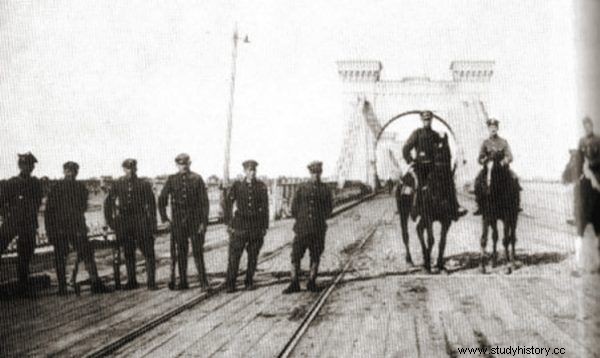
The army of the Second Republic of Poland took Kyiv in May 1920. However, the Soviet counteroffensive soon interrupted the streak of Polish successes ...
At that time, Budyonny was on the Southern Front, making subsequent unsuccessful attempts to capture Lviv. Urged on by recommendations from Moscow, however, he changed the route and set out on August 27 to help Mikhail Tukhachevsky, commanding the Soviet Western Front. The latter tried to save the remnants of his divisions by escaping to the northeast.
Into the battle
The commander of the Horse Army decided to capture Zamość during the march to the north. Seeing this, the officers of the Polish army began planning the battle. It was intended to surround and destroy the grouping. The strike was to be performed by the Polish 3rd Army headed by Lieutenant General Władysław Sikorski. He wanted to bind the main forces of Budyonny near Komarów by a leading strike of the Pursuit Group of Lieutenant General Stanisław Haller . At the same time, the enemy would be flanked by the forces of General Lucjan Żeligowski's 10th Infantry Division and Colonel Michał Żymierski's 2nd Legions Infantry Division.
Budyonny arrived near Zamość in the morning of August 29 and tried to seize the city on the go. The 11th and 14th Cavalry Divisions went on to attack. However, the Bolsheviks encountered decisive resistance from the Ukrainian 6th Sich Rifle Division, with only around 2,000 bayonets, and the Polish 31st Infantry Regiment of Captain Mikołaj Boltuc.
After two days of fighting, the 13th Infantry Division from General Haller's Group arrived at the scene. The Soviet officer, trying to avoid the encirclement, decided to withdraw towards Hrubieszów. However, another unit subordinate to Haller stood in his way:the 1st Cavalry Division of Lieutenant General Juliusz Rómmel. Nevertheless, the Bolsheviks had a considerable advantage:their 6,000 sabers were opposed by only 1,500 Polish ones!
Sabers, lances in hand!
Before the battle began, the opponents analyzed the plan of the area, looking for convenient positions. Colonel Henryk Brzezowski, commander of the 7th Riding Brigade from Rómmel's unit, ordered to occupy especially hill 255. His strategic usefulness was explained in 1934 in the "Przegląd Kawaleryjski" (original spelling was preserved):
After getting familiar with the field and redesigning the map, I decided that I had to take hill 255, north of Wolica Śniatycka, as soon as possible. This was the dominant point that made it possible to observe all the way to Sitno . The possession of this hill secured the approach of the 6th brigade and gave rise to the commencement of our action, in short, hill 255 was the tactical center of gravity in this section.

Semyon Budyonny was at the head of the Soviet 1st Cavalry Army. Photo from 1943.
As the colonel later recalled, at this stage he could not yet notice the enemy. The enemy artillery was firing "from the direction of Cześniki". The officer had two regiments at his disposal:the second cavalrymen and the eighth lancers. The third, 9th Uhlans, has not yet reached Komarovo.
It was not Brzezowski who struck first, however. This role went to Captain Stanisław Maczek, whose Assault Battalion went to the rear of the Soviet divisions. Only then did Brzezowski receive information that the Bolsheviks had taken Wolica Śniatycka. The colonel had to react:he sent not only Cheval Legers to the hill he chose, but also a squadron from the 8th Uhlan Regiment. As he wrote:
The cavalry patrols had not yet reached the top of the mountain when suddenly a large mass of cavalry appeared on the horizon; they were racing south-west . (...) All my attention was focused on the mass that was crashing down on the cavalry regiment. I knew that this regiment could not withstand such a powerful strike, and that it would be relegated to the Sniatic Voltaic in a short time with great losses .
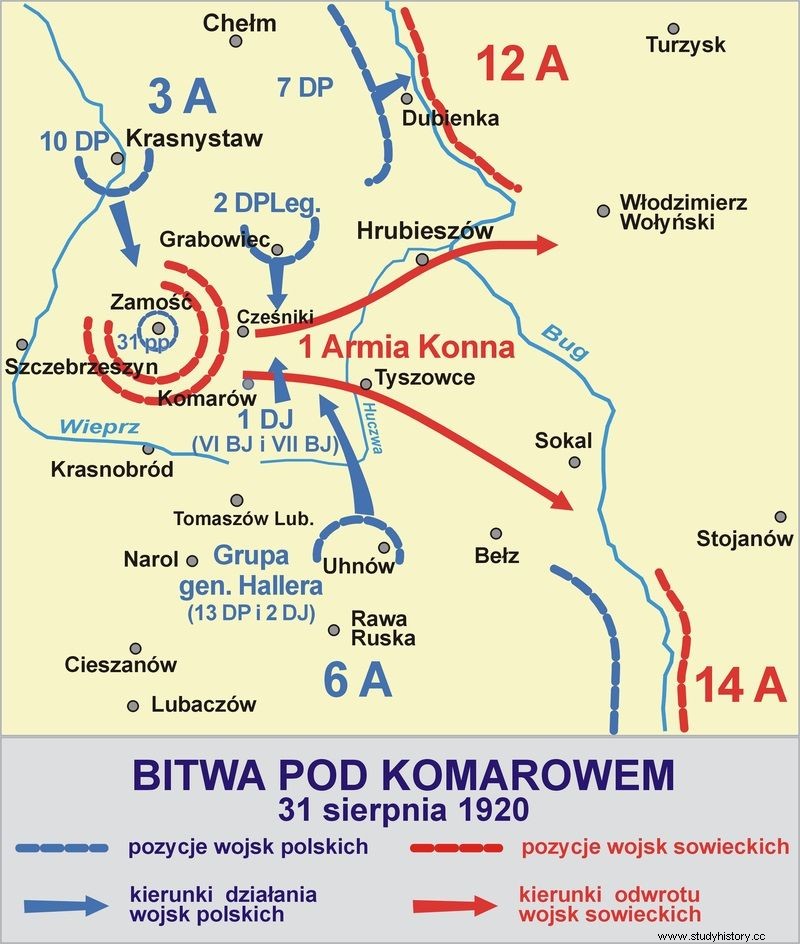
The plan of the Polish command assumed the environs of Budyonny's army. The illustration shows the location of the troops during the battle.
"The crisis has reached its peak"
The cavalrymen, however, did not lay down their weapons before the battle. Seeing the enemy approaching, they charged several times. They continued the fight even after the stronger enemy was rejecting further attacks. But while they were on the field, they grew weaker and weaker. Luckily for the 7th Brigade commander and his subordinates, help finally came:
At this critical moment, Major Dembiński, commander of the 9th Uhlans, reports his arrival with the regiment. He spent the night in Tyszowce, from 5 is on the move and has already covered 20 km. I show him what is happening on the hill and give the order to charge. Major Dembiński is galloping towards his regiment, you can see how the wheelbarrows are galloping out, and behind them the regiment is getting ready to attack.
Major Dembiński's regiment launched an attack. The new forces saved the fighting regiments. This is how Brzezowski related these tense moments:
The crisis has reached its peak. The brigade commander, together with the Moravian Captain, direct the battery fire themselves. Artillery men with burned hands operate the cannons, and next to it, a real redoubt of machine guns is blowing live fire straight ahead into the eastern part of the Śnaticka Wolica. This is where the enemy's attack, looking for our wing, centered. Fortunately, the swampy meadow made it impossible to move quickly in horse formation.
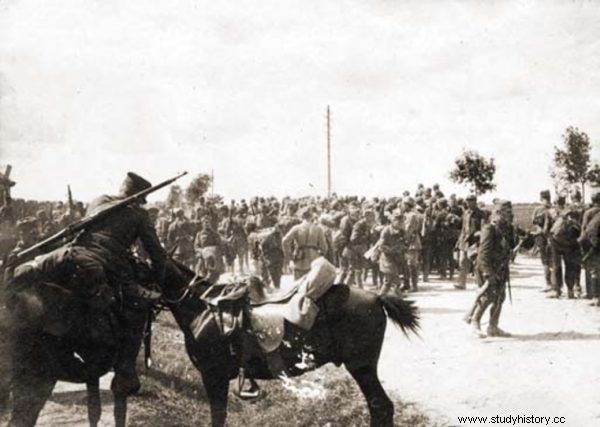
Since the capture of Kiev, Polish troops gradually withdrew. The Battle of Warsaw in the north and at Komarów in the south stopped the losing streak. The photo shows the 3rd Army.
Centered fire forced the enemy to look for a cover outside the village houses. In the foreground, the turmoil continues. You don't understand who beats whom, who wins, but every seasoned soldier feels that it won't take long for a breakdown - it has to happen at any moment .
It was a critical moment in the morning fight. The Soviet 11th Cavalry Division repeatedly counterattacked and smashed the attacks of the 7th Cavalry Brigade. The losses of the Poles were very large. In the 2nd regiment alone, 3 officers and 34 soldiers were killed! The 9th regiment was the worst, thrown into the most heated episodes of the battle. In his three morning charges, as many as 4 squadron commanders and about 50 lancers were killed. Major Dembiński said later:
I realized that the regiment suffered very heavy losses, that the nervous tension is enormous, that if there is a breakdown and retreat, it will be an escape that will not go away so easy to master. You will need fresh troops for this. Personally, I no longer had any reserves, so I lost the possibility to intervene.
Knowing my officers, I knew that the living would not leave the square; further interference in the fight was pointless. So I jumped to my machine guns, got off my blood-shedding chestnut and decided to stay here to organize a possible retreat cover. Luckily the collapse did not happen .
Finally, after another Polish charge, Budyonny's Cossacks slowly began to retreat to the north, beyond Hill 255. Nevertheless, the hand-to-hand combat, led by cavalrymen of the 7th Cavalry Brigade, lasted over two hours. Fortunately, at the most critical moment of the battle, the 6th Riding Brigade came to their rescue. In full run, the uhlans of the 1st and 14th regiments struck the enemy wing. Soviet units were rejected and forced to regroup. This decisive clash did not last even a quarter of an hour. After him, there was a three-hour break in the fight. Both sides used it for reorganization.
Second round
Polish commanders did not give up the plan of surrounding the 1st Cavalry Army. To cut off Budyonny's way of retreat, Colonel Rómmel sent the 12th Uhlans through the marshes to the Bolshevik rear. He intended to close the Soviet troops "in the bag". Unfortunately, his plans were thwarted by… general Haller. He shifted one of the infantry divisions to insure other units. Nothing came out of the encirclement, but the Krechowiec and Yazowiecki lancers set off in pursuit of the retreating Bolshevik divisions.
As a result of these maneuvers, Budyonny was left with only the 4th and 6th Cavalry Divisions, which together had only 800 sabers. With these miserable forces, he decided to hit the column of the 7th Riding Brigade, which was regrouping for the pursuit. It was not a move that Poles expected:
Not even one kilometer had been traveled, when suddenly, at the back of the column, rapid shots began to fall, and a moment later (...) Cossacks flew out and with a wild scream they started facing away from with the back of the column. The surprise was so sudden that it seemed - at any moment a swarm of Cossacks would cover and push into the swamp this slim and unswerving Polish column . However, the 9th Uhlans' regiment walking at the rear immediately took to the battle and set off on the rushing Cossacks.
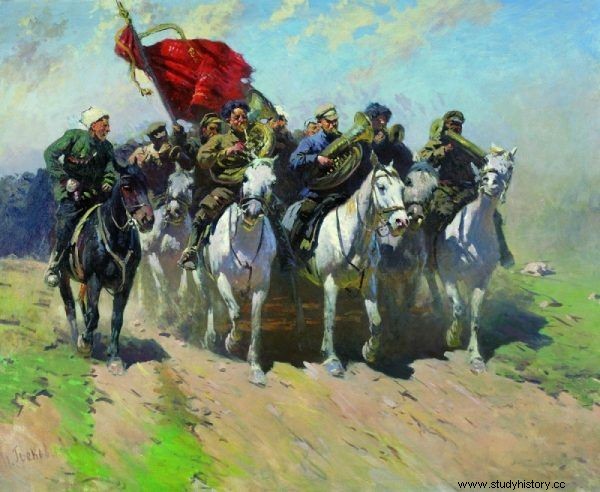
At some points in the battle, the 1st Cavalry Army was about to win.
He failed to pause them though. In the setting sun a forest of crooked sabers gleamed. Red banners fluttered. The wind was blowing red shirts; papachos crowded; shaggy horses puffed out of breath, the Mongol mob raged with their wild boar.
However, the Polish troops could not be broken. When the 9th regiment received the first strike, the 8th regiment of lancers also attacked. Soon the Cossack column scattered under the impact of a squadron of machine guns . This allowed the cavalrymen of the 9th regiment to return to the battlefield. A moment later they were joined by a squadron of Krechowiec lancers headed by Colonel Rómmel. After their attack, the opponent started to run away.
The reserve divisions were finally broken thanks to the 8th Regiment of Captain Kornel Krzeczunowicz. At full gallop, the ranks of the Bolsheviks were broken, even forcing the general commander himself to abandon his staff car. No wonder that after the war Rómmel described this charge as one of the finest of the entire war.
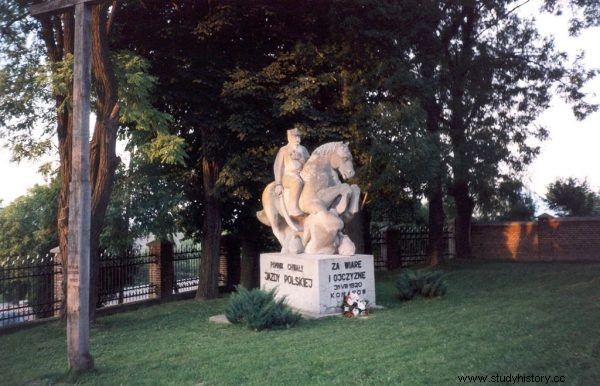
In Komarów there is a monument commemorating the victory of Poles.
Missed opportunity
The victory was complete. The Poles set off in pursuit, which, however, after about three kilometers, was stopped by machine guns set at the edge of the forest. The further pursuit was abandoned due to the falling darkness and the excursion of soldiers who had been fighting for 12 hours. Although the 2nd Legions Infantry Division of Colonel Żymierski was sent to cut off the Bolsheviks' retreat, it let most of the units of the 1st Cavalry Army pass through errors of command.
After the battle of Komarów, Budyonny's army was no longer a force that could threaten the Poles . While at the end of May, when crossing the Dnieper, it had more than 20,000 sabers, only 3,000 soldiers were withdrawn after the August clash. On September 25, the army was withdrawn from the battle against the Poles.
